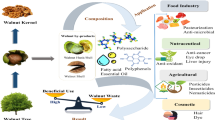Abstract
Sorghum is a cereal with little use in human diet; however, this grain can provide several nutrients and, additionally, has a high content of phenolic compounds concentrated in bran, which could be beneficial to human health due to its high antioxidant capacity. However, these bioactive compounds are bound within the cell wall matrix; it is necessary to release these compounds to take advantage of their antioxidant properties. The extrusion process increases the accessibility of bound phenolic compounds, breaking their bonds from the bran matrix. The aim of this study was to determine the optimal extrusion conditions for maximizing the phenolic compound content and antioxidant capacity of sorghum bran extrudate. The extrusion process factors evaluated were feed moisture (FM) from 25 to 35% and the fourth extrusion zone temperature (T) in the range of 140–180 °C. Analysis of variance and response surface analysis were used in the evaluation. The prediction coefficient, (FM)2, (T)2 and their interaction (FM)(T) significantly affected the free total phenolic compounds. The antioxidant capacity of the free total phenolic compounds was significantly affected by (FM)2 and (T)2. The optimal extrusion conditions were FM = 30% and T = 160 °C, which provided free total phenolic compounds with a value of 7428.95 μg GAE/g (predicted value: 7810.90 μg GAE/g) and antioxidant capacity with a value of 14.12 μmol TE/g (predicted value: 14.85 μmol TE/g). Results confirmed that extrusion process optimization was useful to increase the content of phenolic compounds and improved the antioxidant capacity of sorghum bran.



Similar content being viewed by others
References
FAO (2017). FAOSTAT. Retrieved December 16, 2019, from World Crops Website. http://www.fao.org/faostat/en/#data/QC
Duodu KG, Taylor JRN, Belton PS, Hamaker BR (2003) Factors affecting sorghum protein digestibility. J Cereal Sci 38:117–131
Dykes L, Peterson GC, Rooney WL, Rooney LW (2011) Flavonoid composition of lemon-yellow sorghum genotypes. Food Chem 128:173–179
Svensson L, Sekwati-Monang B, Lutz DL, Schieber A, Gänzle MG (2010) Phenolic acids and flavonoids in nonfermented and fermented red sorghum (Sorghum bicolor (L.) Moench). J Agric Food Chem 58:9214–9220
Dicko MH, Gruppen H, Traoré AS, Voragen AGJ, Van Berkel WJH (2006) Sorghum grain as human food in Africa: relevance of content of starch and amylase activities. Afr J Biotechnol 5:384–395
Fardet A (2010) New hypotheses for the health-protective mechanisms of whole-grain cereals: what is beyond fibre? Nutr Res Rev 23:65–134
Shahidi F, Ambigaipalan P (2015) Phenolics and polyphenolics in foods, beverages and spices: antioxidant activity and health effects–a review. J Funct Foods 18:820–897
Luzardo-Ocampo I, Ramírez-Jiménez AK, Cabrera-Ramírez ÁH, Rodríguez-Castillo N, Campos-Vega R, Loarca-Piña G, Gaytán-Martínez M (2020) Impact of cooking and nixtamalization on the bioaccessibility and antioxidant capacity of phenolic compounds from two sorghum varieties. Food Chem 309:125684
Dykes L, Rooney LW (2006) Sorghum and millet phenols and antioxidants. J Cereal Sci 44:236–251
Zielinski H, Kozlowska H, Lewczuk B (2001) Bioactive compounds in the cereal grains before and after hydrothermal processing. Innov Food Sci Emerg 2:159–169
Acosta-Estrada BA, Gutiérrez-Uribe JA, Serna-Saldívar SO (2014) Bound phenolics in foods, a review. Food Chem 152:46–55
Adarkwah-Yiadom M, Duodu KG (2017) Effect of extrusion cooking and simulated in vitro gastrointestinal digestion on condensed tannins and radical scavenging activity of type II and type III whole grain sorghum. Int J Food Sci Tech 52(10):2282–2294
Wang T, He F, Chen G (2014) Improving bioaccessibility and bioavailability of phenolic compounds in cereal grains through processing technologies: a concise review. J Funct Foods 7:101–111
Gu L, House SE, Rooney LW, Prior RL (2008) Sorghum extrusion increases bioavailability of catechins in weanling pigs. J Agric Food Chem 56 (4):1283–1288
Buitimea-Cantúa NE, Torres-Chávez PI, Ramírez-Wong B, Serna-Saldívar SO, Rouzaud-Sández O, Rosas-Burgos EC, Platt-Lucero LC, Salazar-García MG (2017) Phenolic compounds and antioxidant activity of extruded nixtamalized corn flour and tortillas enriched with sorghum bran. Cereal Chem 94(2):277–283
Wang S, Nosworthy MG, House JD, Niefer SH, Nickerson MT (2019) Effect of barrel temperature and feed moisture on protein quality in pre-cooked Kabuli chickpea, sorghum, and maize flours. Food Sci Technol Int. https://doi.org/10.1177/1082013219887635
Ramos-Enríquez JR, Ramírez-Wong B, Robles-Sánchez RM, Robles-Zepeda RE, González-Aguilar GA, Gutiérrez-Dorado R (2018) Effect of extrusion conditions and the optimization of phenolic compound content and antioxidant activity of wheat bran using response surface methodology. Plant Foods Hum Nutr 73:228–234
Dlamini NR, Taylor JRN, Rooney LW (2007) The effect of sorghum type and processing on the antioxidant properties of African sorghum-based foods. Food Chem 105:1412–1419
Taylor JR, Duodu KG (2015) Effects of processing sorghum and millets on their phenolic phytochemicals and the implications of this to the health-enhancing properties of sorghum and millet food and beverage products. J Sci Food Agric 95(2):225–237
American Association of Cereal Chemists (2000) Approved methods of the AACC. In: Method 46–13, 10th edn. The Association, St. Paul
Escalante-Aburto A, Ramírez-Wong B, Torres-Chávez P, López-Cervantes J, Figueroa-Cárdenas J, Barrón-Hoyos J, Gutiérrez-Dorado R (2014) Obtaining ready-to-eat blue corn expanded snacks with anthocyanins using an extrusion process and response surface methodology. Molecules 19(12):21066–21084
Ti H, Zhang R, Zhang M, Wei Z, Chi J, Deng Y, Zhang Y (2015) Effect of extrusion on phytochemical profiles in milled fractions of black rice. Food Chem 178:186–194
de Morais CL, Pinheiro SS, de Carvalho CWP, Queiroz VAV, de Menezes CB, Moreira AVB, de Barros FAR et al (2015) Phenolic compounds profile in sorghum processed by extrusion cooking and dry heat in a conventional oven. J Cereal Sci 65:220–226
Sharma P, Gujral HS, Singh B (2012) Antioxidant activity of barley as affected by extrusion cooking. Food Chem 131:1406–1413
Brennan C, Brennan M, Derbyshire E, Tiwari BK (2011) Effects of extrusion on the polyphenols, vitamins and antioxidant activity of foods. Trends Food Sci Technol 22:570–575
Altan A, McCarthy KL, Maskan M (2009) Effect of extrusion process on antioxidant activity, total phenolics and β-glucan content of extrudates developed from barley-fruit and vegetable by-products. Int J Food Sci Tech 44:1263–1271
Rudra SG, Jakhar N, Nishad J, Saini N, Sen S, Bhardhwaj R, Kaur C (2015) Extrusion conditions and antioxidant properties of sorghum, barley and horse gram based snack. Vegetos 28(2):171–182
Esposito F, Arlotti G, Bonifati AM, Napolitano A, Vitale D, Fogliano V (2005) Antioxidant activity and dietary fibre in durum wheat bran by-products. Food Res Int 38:1167–1173
Salazar Lopez NJ, Loarca-Piña G, Campos-Vega R, Gaytán Martínez M, Morales Sánchez E, Esquerra-Brauer JM et al (2016) The extrusion process as an alternative for improving the biological potential of sorghum bran: phenolic compounds and antiradical and anti-inflammatory capacity. Evid Based Complement Alternat Med 2016:8387975
Acknowledgements
Raquel A. Ortiz-Cruz wants to thank CONACyT for providing a scholarship for her Ph.D. studies. The authors would like to thank M.C. Ignacio Morales-Rosas for his help in the performance of the extrusion experiments.
Author information
Authors and Affiliations
Corresponding author
Ethics declarations
Conflict of Interest
The authors declare that there are no conflicts of interest.
Additional information
Publisher’s Note
Springer Nature remains neutral with regard to jurisdictional claims in published maps and institutional affiliations.
Electronic Supplementary Material
ESM 1
(DOCX 24 kb)
Rights and permissions
About this article
Cite this article
Ortiz-Cruz, R.A., Ramírez-Wong, B., Ledesma-Osuna, A.I. et al. Effect of Extrusion Processing Conditions on the Phenolic Compound Content and Antioxidant Capacity of Sorghum (Sorghum bicolor (L.) Moench) Bran. Plant Foods Hum Nutr 75, 252–257 (2020). https://doi.org/10.1007/s11130-020-00810-6
Published:
Issue Date:
DOI: https://doi.org/10.1007/s11130-020-00810-6




